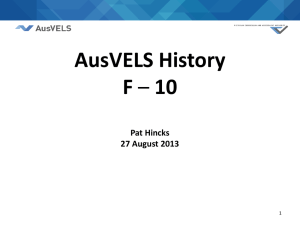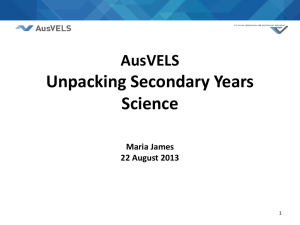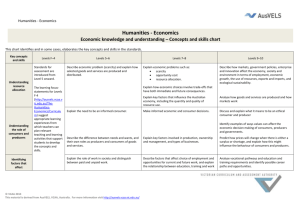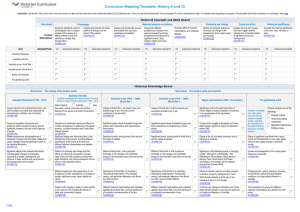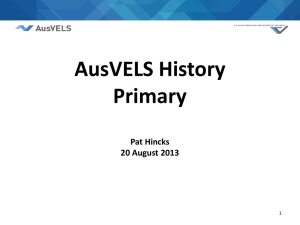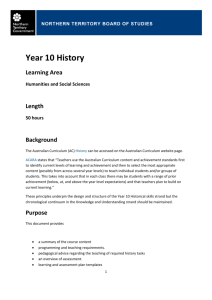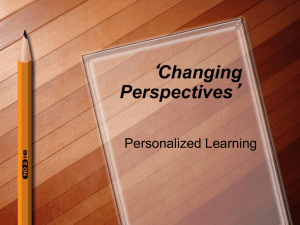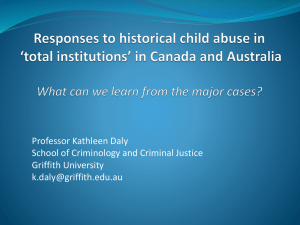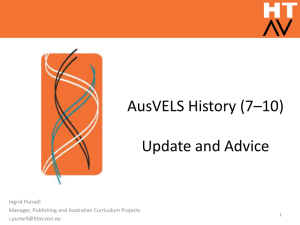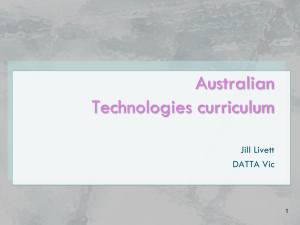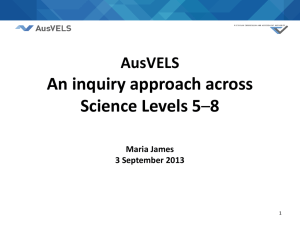Introducing AusVELS History 7 – 10
advertisement
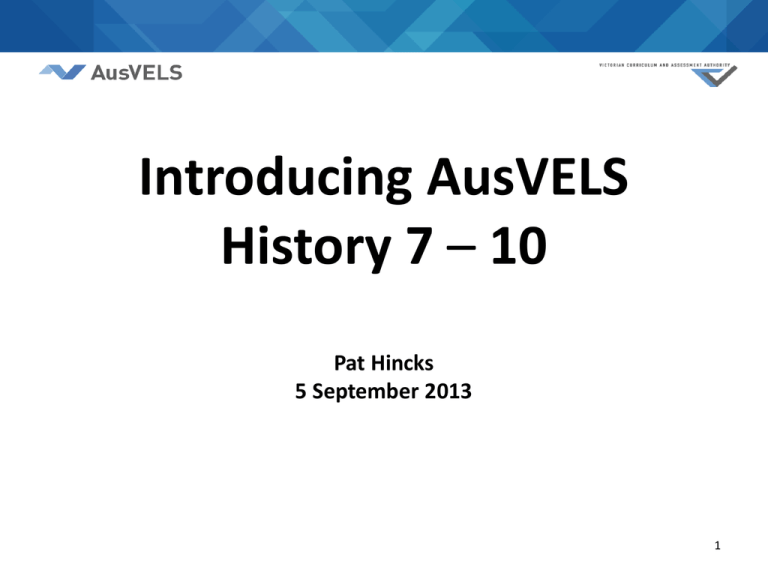
Introducing AusVELS History 7 – 10 Pat Hincks 5 September 2013 1 Aims: • Answer questions about history • Outline the aims and structure and content of the history curriculum • Set out the historical sequence 7 – 10 • Explore the qualities of the achievement standards • Unpack a Depth study • Provide information on support resources: VCAA/HTAV/Scootle 2 History: Common questions • • • • • Is there a mandated time? What is the status of the elaborations? Can we ‘integrate’ history with other subjects? Is history mandated in Years 9 and 10? Can we mix/match Depth studies? 3 History and time allocation There is no time allocation which is mandated for AusVELS History. However: History F – 2 was written for 20 hours a year History 3 – 6 was written for 40 hours a year History 7 – 10 was written for 50 hours a year Source: Curriculum Design Paper, ACARA, http://www.acara.edu.au/curriculum/curriculum_design_and_development.html 4 Curriculum – not pedagogy Jurisdictions, systems and schools will be able to implement the Australian Curriculum in ways that value teachers’ professional knowledge, reflect local contexts and take into account individual students’ family, cultural and community backgrounds. Schools and teachers determine pedagogical and other delivery considerations. (Source: The Shape of the Australian Curriculum, ACARA, www.acara.edu.au ) 5 Humanities and Social Sciences Curriculum History Geography Civics and Citizenship Economics and Business F-2 20 hours per year 20 hours per year NIL NIL 3-4 40 hours per year 40 hours per year 20 hours per year NIL 5-6 40 hours per year 40 hours per year 20 hours per year 20 hours per year 7-8 50 hours per year 50 hours per year 20 hours per year 20 hours per year 9-10 50 hours per year 50 hours per year 20 hours per year 50 hours per year 6 Rationale Depth Studies Knowledge and understanding Content descriptions Elaborations Level descriptions Achievement standards Cross curriculum priorities Aims Skills Overviews Concepts 7 RATIONALE: History is a disciplined process of inquiry into the past that develops students' curiosity and imagination. Awareness of history is an essential characteristic of any society, and historical knowledge is fundamental to understanding ourselves and others. It promotes the understanding of societies, events, movements and developments that have shaped humanity from earliest times. It helps students appreciate how the world and its people have changed, as well as the significant continuities that exist to the present day. History, as a discipline, has its own methods and procedures which make it different from other ways of understanding human experience. The study of history is based on evidence derived from remains of the past. It is interpretative by nature, promotes debate and encourages thinking about human values, including present and future challenges. The process of historical inquiry develops transferable skills, such as the ability to ask relevant questions; critically analyse and interpret sources; consider context; respect and explain different perspectives; develop and substantiate interpretations, and communicate effectively. 8 AIMS: The Australian Curriculum: History aims to ensure that students develop: • interest in, and enjoyment of, historical study for lifelong learning and work, including their capacity and willingness to be informed and active citizens • knowledge, understanding and appreciation of the past and the forces that shape societies, including Australian society • understanding and use of historical concepts, such as evidence, continuity and change, cause and effect, perspectives, empathy, significance and contestability • capacity to undertake historical inquiry, including skills in the analysis and use of sources, and in explanation and communication. 9 History: Structure Secondary AusVELS History Explanations Level Descriptions a) Overview of the level Content b) Key concepts of history understanding c) Key inquiry questions a) What will be taught at that level b) Continuity and change, cause and effect, perspectives, empathy and significances, evidence, contestability c) Inquiry questions frame teaching and learning for that level Content Descriptions a) Historical knowledge and understanding Overview Depth Studies b) Historical skills Knowledge and understanding strands are level by level Historical skills strands in two level bands Overviews provide a context for the level Varying choice in Depth Studies Achievement Standards Focus on understanding and skills Describe what students know and can do at each level 10 Level Content Level 7 The Ancient World Level 8 The Ancient to the Modern World The Level 7 curriculum provides a study of history from the time of the earliest human communities to the end of the ancient period, approximately 60,000BC (BCE)– c. 650AC (CE)…. a range of societies including Australia, Egypt, Greece, Rome, China and India. The Level 8 curriculum provides a study of history from the end of the ancient period to the beginning of the modern period c650AD (CE) – 1750. …when major civilisations around the world came into contact with each other. Social, economic, religious and political beliefs were often challenged and significantly changed. Concepts of historical understanding evidence, continuity and change, cause and effect, perspectives, empathy, significance and contestability Key questions How do we know about the ancient past? Why and where do the first human communities develop? What emerged as the defining characteristics of ancient societies? How did societies change from the end of the ancient period to the beginning of the modern age? What key beliefs and values emerged and how did they influence societies? What were the causes and effects of contact between societies in this period? What have been the legacies of ancient societies? Which significant people, groups and ideas from this period have influenced the world today? 11 Level Content Concepts of historical understanding Key questions Level 9 The Making of the Modern World Level 10 The Modern World and Australia The Level 9 curriculum provides a study of the making of the modern world from 1750 to 1918. It was a period of industrialisation and rapid change in the way people lived, worked and thought. It was an era of nationalism and imperialism and the colonisation of Australia….culminated in WW1… The Level 10 curriculum provides a history of the modern world and Australia from 1918 to the present with an emphasis on Australia in its global context….became a critical period in Australia’s social, cultural, economic and political development…..a time of political turmoil, global conflict and international cooperation…Australia’s place. evidence, continuity and change, cause and effect, perspectives, empathy, significance and contestability How did the nature of global conflict change during the twentieth century? What were the consequences of World War II? How did these consequences shape the modern world? How was Australian society affected by other significant global events and changes in this period? How did the nature of global conflict change during the twentieth century? What were the consequences of World War II? How did these consequences shape the modern world? How was Australian society affected by other significant global events and changes during this period? 12 Historical understanding Underpin both strands and a particular focus in the achievement standards: continuity and change, cause and effect, perspectives, significance, evidence and contestability • Can become the focus questions in teaching and learning activities • EG. Continuity and change: What’s the same? Different? Why? • EG Cause and effect: What motivated young Australians to go to war? Why did the environment become a political issue in the 1970s and 80s? What were the short term and long term causes of WWII? What impact did Australia’s signing of the UNDR have on Australia? • EG Perspectives: Whose viewpoint? How the same/different from others? What shaped/ possibly shaped particular views of events, people etc.? 13 Depth Studies Level 7 Level 8 Level 9 Level 10 Depth study 1: Investigating the Ancient Past Depth study 1: Western/Islamic World Ottoman Empire OR Renaissance Italy OR The Vikings OR Medieval Europe Depth study 1: Making a better world? The Industrial Revolution OR Progressive ideas and movements OR Movement of peoples Depth study 1: World War 11 Depth study 2: The Mediterranean World Egypt OR Greece OR Rome Depth study 2: Asia-Pacific World Angkor/Khmer Empire OR Japan under the Shoguns OR The Polynesian expansion Depth study 2: Australia and Asia Asia and the World OR Making a nation Depth study 2: Rights and Freedoms Depth study 3: World War 1 Depth study 3: The globalising world Popular culture OR Migration experiences OR The environment movement Depth study 3: The Asian World India OR China Depth Study 3: Expanding contacts Mongol expansion OR The Black Death OR The Spanish conquest of the Americas 14 Elaborations 15 Skills 7-8 9 - 10 Chronology, terms and concepts Sequence historical events, developments and periods Use historical terms and concepts Use chronological sequencing to demonstrate the relationship between events and developments in different periods and places Use historical terms and concepts Historical questions and research Identify a range of questions about the past to inform an historical inquiry Identify and locate relevant sources, using ICT and other methods Identify and select different kinds of questions about the past to inform an historical inquiry Evaluate and enhance those questions Identify and locate relevant sources, using ICT and other methods Analysis and use of sources Identify the origin and purpose of primary and secondary sources Locate, compare, select and use information from a range of sources as evidence Draw conclusions about the usefulness of sources Identify the origin, purpose and context of primary and secondary sources Process and synthesise information from a range of sources for use as evidence in an historical argument Evaluate the reliability and usefulness of primary and secondary sources Perspectives and interpretations Identify and describe points of view, attitudes and values in primary and secondary sources Identify and analyse the perspectives of people from the past Identify and analyse different historical interpretations ( including their own) Explanation and communication Develop texts, particularly descriptions and explanations that use evidence from a range of sources that are acknowledged 16 Develop texts, particularly descriptions and discussions that use evidence from a range of sources that are referenced Achievement standards • Level by level • Two paragraphs 1) understanding 2) skills • Designed to answer the question: What do I want students to understand and be able to do at this year level? • Used with the content descriptions to plan curriculum. The Knowledge and understanding and Skills strands provide the content that allows students to reach the standards. 17 Level 8 Achievement Standard By the end of Level 8, students recognise and explain patterns of change and continuity over time. They explain the causes and effects of events and developments. They identify the motives and actions of people at the time. Students explain the significance of individuals and groups and how they were influenced by the beliefs and values of their society. They describe different interpretations of the past. Students sequence events and developments within a chronological framework with reference to periods of time. When researching, students develop questions to frame an historical inquiry. They analyse, select and organise information from primary and secondary sources and use it as evidence to answer inquiry questions. Students identify and explain different points of view in sources. When interpreting sources, they identify their origin and purpose, and distinguish between fact and opinion. Students develop texts, particularly descriptions and explanations, incorporating analysis. In developing these texts, and organising and presenting their findings, they use historical terms and concepts, evidence identified in sources, and acknowledge their sources of information 18 Mixing Depth Studies The content in each elective is designed to allow detailed study of specific aspects of the historical period. The order and detail in which content is taught is a programming decision. Content may be integrated in ways appropriate to the specific local context; and it may be integrated with the content of other depth-study electives. http://ausvels.vcaa.vic.edu.au/The-Humanities-History/Overview/Content-structure 19 Depth Studies • Rights and freedoms (1945 – the present) – The origins and significance of the Universal Declaration of Human Rights, including Australia’s involvement in the development of the declaration (ACDSEH023) – Background to the struggle of Aboriginal and Torres Strait Islander peoples for rights and freedoms before 1965, including the 1938 Day of Mourning and the Stolen Generations (ACDSEH104) – The US civil rights movement and its influence on Australia (ACDSEH105) – The significance of the following for the civil rights of Aboriginal and Torres Strait Islander peoples: 1962 right to vote federally; 1967 Referendum; Reconciliation; Mabo decision; Bringing Them Home Report (the Stolen Generations), the Apology (ACDSEH106) – Methods used by civil rights activists to achieve change for Aboriginal and Torres Strait Islander peoples, and the role of ONE individual or group in the struggle (ACDSEH134) – The continuing nature of efforts to secure civil rights and freedoms in Australia and throughout the world, such as the Declaration on the Rights of Indigenous Peoples (2007) (ACDSEH143) 20 Level 10 Achievement Standard By the end of Level 10, students refer to key events, the actions of individuals and groups, and beliefs and values to explain patterns of change and continuity over time. They analyse the causes and effects of events and developments and explain their relative importance. They explain the context for people’s actions in the past. Students explain the significance of events and developments from a range of perspectives. They explain different interpretations of the past and recognise the evidence used to support these interpretations. Students sequence events and developments within a chronological framework, and identify relationships between events across different places and periods of time. When researching, students develop, evaluate and modify questions to frame an historical inquiry. They process, analyse and synthesise information from a range of primary and secondary sources and use it as evidence to answer inquiry questions. Students analyse sources to identify motivations, values and attitudes. When evaluating these sources, they analyse and draw conclusions about their usefulness, taking into account their origin, purpose, and context. They develop and justify their own interpretations about the past. Students develop texts, particularly explanations and discussions, incorporating historical argument. In developing these texts and organising and presenting their arguments, they use historical terms and concepts, 21 evidence identified in sources, and they reference these sources. One approach Focus Assessment Task Elements of the Achievement Standards The 1967 Referendum Source analysis Students: explain the significance of events and developments from a range of perspectives. explain different interpretations of the past analyse sources to identify motivations, values and attitudes use historical terms and concepts The Mabo Decision Research report on significance process, analyse and synthesise information from a range of primary and secondary sources and use it as evidence to answer inquiry questions. develop and justify their own interpretations about the past they use historical terms and concepts, evidence identified in sources, and they reference these sources. 22 Examples of a Sequence Examples of activities What rights should all Australian citizens expect? Analysis of rights in the United Nations Declaration of Human Rights How do these rights compare with those of Aborigines in the 1960s? Some explanations/ analysis of Rights of Aborigines in States and Territories Life in Missions and reserves Stolen Generations stories What’s a referendum? Construct a flowchart of referendum process. Explain implications of sections 51 and 127 of Constitution Who led the campaign? Views and achievements of Aboriginal activists and supporters ( eg Doug Nicholls and the MCG.) What did the Referendum leaflets, songs, posters, slogans say? Analysis of : Values and attitudes Arguments and evidence What was the result? Analysis of results State by state. How significant? Views of Aborigines ( eg Faith Bandler) Other perspectives ( eg Federal Government action) 23 24 AusVELS Resources and Support http://www.vcaa.vic.edu.au/Pages/foundation1 0/curriculum/index.aspx General advice and FAQs etc Under History menu • Summaries of differences between AusVELS and VELS • Planning templates • Progression Points 25 Progression point examples • Assist teachers in the assessment and reporting of student achievement. • In AusVELS, the progression point examples are provided in 0.5 increments. Progression point examples are designed to: Progression point examples are NOT designed to: • illustrate how a student might show evidence of progression • be used in conjunction with other tools such as annotated student work samples • be modified by schools so that the examples reflect the curriculum structure and timing of when knowledge and skills are taught and assessed • replace standards • be used as a definitive or mandated set of progression measures for student assessment • be the only resource used by teachers to assign progression points on student reports 26 Select aspect of content descriptions Develop assessment tasks that will allow students to demonstrate aspects of achievement standards 27 Do all students in Years 9-10 have to study the Australian Curriculum/AusVELS? The Victorian Minister for Education has endorsed the implementation of the Australian Curriculum for English, Mathematics, History and Science in Victorian schools F-10 from 2013. There is therefore now an expectation that all students will have access to the content defined by the curriculum for these subject across the years F–10 and that, for most students, their program of learning will include assessment of their learning of this content. Exceptions might include students who are following individual learning plans, students undertaking school-based apprenticeships or students undertaking VCE studies in Year 10. http://www.vcaa.vic.edu.au/Pages/foundation10/curriculum/faq.aspx#9_10 28 Can we ‘integrate’ content? • Yes, but we are not re-creating SOSE! • Curriculum content can be meaningfully put together based on a particular context or theme. • Eg: Obvious links with Geography, Civics and Citizenship, Economics. • Eg: text selection in English such as ‘A Long Way Home’, ‘Saroo Brierly’ and ‘Immigration’. 29 HTAV School/network based PD ( Jo Clyne, Education Officer) Primary and Secondary Resources: Login> Members only> Resources http://www.htav.asn.au/home 30 Additional resources • http://www.historyteacher.org.au/ • www.scootle.edu.au 31 History: Common questions • • • • • Is there a mandated time? What is the status of the elaborations? Can we ‘integrate’ history with other subjects? Is history mandated in Years 9 and 10? Can we mix/match Depth studies? 32 Victorian Curriculum and Assessment Authority (VCAA) www.vcaa.vic.edu.au Pat Hincks Humanities and Social Sciences Curriculum Manager hincks.patricia.m@edumail.vic.gov.au 33
